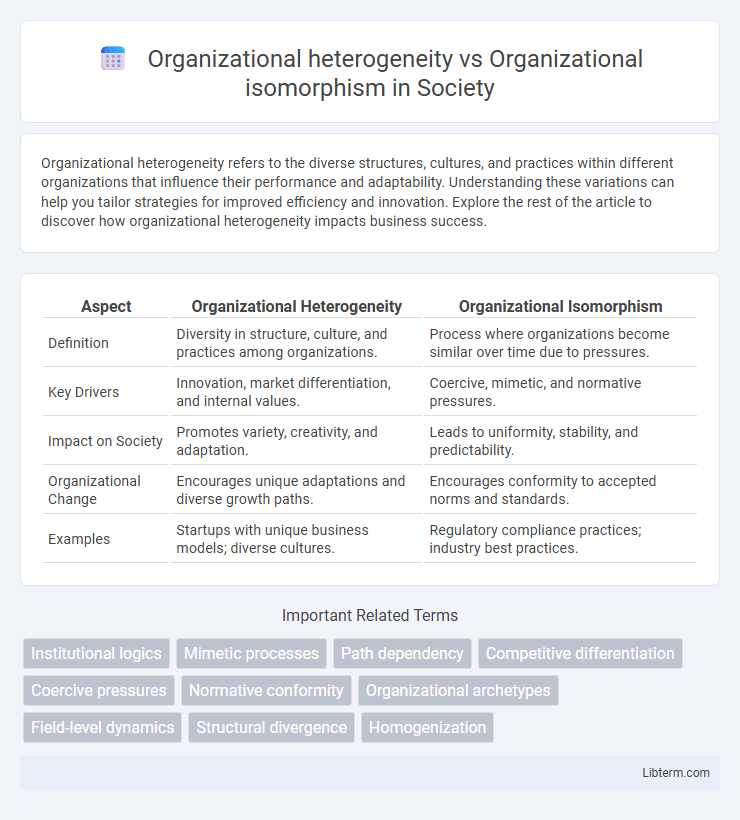Organizational heterogeneity refers to the diverse structures, cultures, and practices within different organizations that influence their performance and adaptability. Understanding these variations can help you tailor strategies for improved efficiency and innovation. Explore the rest of the article to discover how organizational heterogeneity impacts business success.
Table of Comparison
| Aspect | Organizational Heterogeneity | Organizational Isomorphism |
|---|---|---|
| Definition | Diversity in structure, culture, and practices among organizations. | Process where organizations become similar over time due to pressures. |
| Key Drivers | Innovation, market differentiation, and internal values. | Coercive, mimetic, and normative pressures. |
| Impact on Society | Promotes variety, creativity, and adaptation. | Leads to uniformity, stability, and predictability. |
| Organizational Change | Encourages unique adaptations and diverse growth paths. | Encourages conformity to accepted norms and standards. |
| Examples | Startups with unique business models; diverse cultures. | Regulatory compliance practices; industry best practices. |
Introduction to Organizational Heterogeneity and Isomorphism
Organizational heterogeneity refers to the distinct differences among firms in structure, strategy, and resource capabilities that create competitive advantages and diversity in market behavior. Organizational isomorphism, by contrast, explains the process through which organizations become increasingly similar due to coercive, mimetic, and normative pressures within institutional environments. Understanding these phenomena provides insights into why organizations either maintain unique identities or conform to industry norms in response to external and internal influences.
Defining Organizational Heterogeneity
Organizational heterogeneity refers to the distinct differences in structures, cultures, strategies, and processes among organizations within the same industry or sector. This concept emphasizes the unique capabilities and resource configurations that lead to varied performance outcomes and competitive advantages. In contrast, organizational isomorphism describes the tendency of organizations to become similar due to institutional pressures, mimetic behaviors, or normative forces.
Understanding Organizational Isomorphism
Organizational isomorphism refers to the process by which organizations within the same field become increasingly similar due to coercive, mimetic, and normative pressures, promoting uniformity in structures and practices. This phenomenon contrasts with organizational heterogeneity, where diversity and variation in strategies, cultures, and structures are maintained across organizations. Understanding organizational isomorphism is crucial for analyzing how institutional forces drive convergence, impacting organizational behavior, legitimacy, and competitive dynamics.
Theoretical Foundations: Institutional Theory
Organizational heterogeneity reflects the diverse strategies, structures, and behaviors organizations adopt to achieve competitive advantage, grounded in contingency and resource-based theories. Organizational isomorphism, explained by institutional theory, emphasizes conformity to institutional norms, rules, and cultural expectations to gain legitimacy and social acceptance within organizational fields. Institutional theory's mechanisms--coercive, mimetic, and normative isomorphism--drive organizations to adopt similar practices despite differing contexts, highlighting the tension between uniqueness and homogeneity in organizational behavior.
Drivers of Organizational Heterogeneity
Organizational heterogeneity arises from diverse factors including unique resource capabilities, distinct strategic goals, and varied environmental interactions, leading to differences in structure and processes across firms. In contrast, organizational isomorphism emphasizes the convergence of organizational practices due to coercive, mimetic, and normative pressures within institutional environments. Drivers of organizational heterogeneity primarily involve idiosyncratic internal resources, innovation dynamics, and differential access to knowledge, which enable firms to develop distinctive competitive advantages despite external homogenizing forces.
Mechanisms and Types of Isomorphism
Organizational heterogeneity refers to the diversity of structures, processes, and strategies across firms, influenced by unique environmental pressures, resources, and managerial choices, while organizational isomorphism explains the process through which organizations become similar due to coercive, mimetic, and normative mechanisms. Coercive isomorphism occurs through formal and informal pressures from powerful entities such as regulators or major clients; mimetic isomorphism arises when organizations imitate others in response to uncertainty; normative isomorphism stems from professionalization and shared norms established by educational and professional networks. Understanding these distinct mechanisms helps explain why organizations exhibit both diversity and convergence in practices, adapting to environmental variability while conforming to institutional pressures.
Impacts on Innovation and Adaptability
Organizational heterogeneity fosters innovation by encouraging diverse perspectives and unique problem-solving approaches, which enhance adaptability to dynamic market conditions. In contrast, organizational isomorphism tends to standardize practices, limiting creative variation but promoting stability and predictability in processes. Balancing heterogeneity and isomorphism enables firms to innovate while maintaining sufficient structure for scalable adaptation.
Industry Examples: Heterogeneity vs Isomorphism
Organizational heterogeneity is evident in the tech industry where firms like Apple and Google develop distinct cultures, strategies, and product innovations, reflecting diverse competitive advantages. In contrast, the fast-food sector showcases organizational isomorphism, with chains such as McDonald's and Burger King adopting similar operational models, branding strategies, and menu formats to meet industry standards and customer expectations. These patterns highlight how heterogeneity drives differentiation, while isomorphism promotes conformity within industry boundaries.
Balancing Uniqueness and Conformity
Organizational heterogeneity emphasizes the unique resources, cultures, and strategies that differentiate firms within an industry, fostering innovation and competitive advantage. Organizational isomorphism drives conformity through coercive, mimetic, and normative pressures, aligning structures and practices to industry standards and enhancing legitimacy. Balancing uniqueness and conformity requires firms to selectively adopt standardized practices while preserving distinctive capabilities that sustain long-term performance and adaptability.
Future Trends in Organizational Structures
Future trends in organizational structures emphasize balancing organizational heterogeneity, which fosters innovation through diverse processes and cultures, against organizational isomorphism, where firms adopt similar frameworks to gain legitimacy and efficiency. Advances in digital transformation and artificial intelligence contribute to hybrid models blending unique organizational identities with standardized practices for scalability. Embracing this dynamic enables companies to remain adaptive while benefiting from proven structural norms in a rapidly evolving business landscape.
Organizational heterogeneity Infographic

 libterm.com
libterm.com